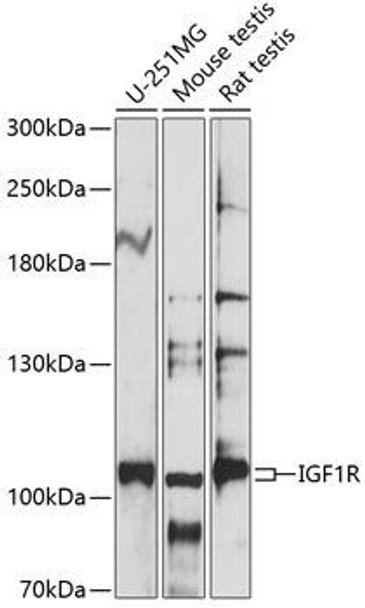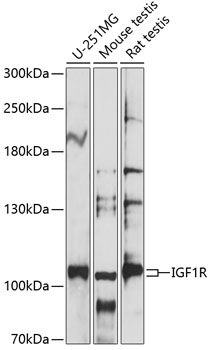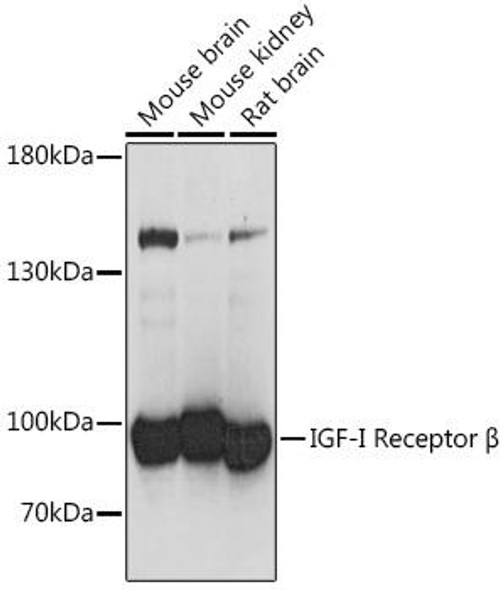Anti-IGF1R Antibody (CAB14698)
- SKU:
- CAB14698
- Product type:
- Antibody
- Reactivity:
- Human
- Mouse
- Rat
- Host Species:
- Rabbit
- Isotype:
- IgG
- Antibody Type:
- Polyclonal Antibody
- Research Area:
- Cell Biology
Description
| Antibody Name: | Anti-IGF1R Antibody |
| Antibody SKU: | CAB14698 |
| Antibody Size: | 20uL, 50uL, 100uL |
| Application: | WB |
| Reactivity: | Human, Mouse, Rat |
| Host Species: | Rabbit |
| Immunogen: | Recombinant fusion protein containing a sequence corresponding to amino acids 741-910 of human IGF1R (NP_000866.1). |
| Application: | WB |
| Recommended Dilution: | WB 1:500 - 1:2000 |
| Reactivity: | Human, Mouse, Rat |
| Positive Samples: | U-251MG, Mouse testis, Rat testis |
| Immunogen: | Recombinant fusion protein containing a sequence corresponding to amino acids 741-910 of human IGF1R (NP_000866.1). |
| Purification Method: | Affinity purification |
| Storage Buffer: | Store at -20°C. Avoid freeze / thaw cycles. Buffer: PBS with 0.02% sodium azide, 50% glycerol, pH7.3. |
| Isotype: | IgG |
| Sequence: | DVMQ VANT TMSS RSRN TTAA DTYN ITDP EELE TEYP FFES RVDN KERT VISN LRPF TLYR IDIH SCNH EAEK LGCS ASNF VFAR TMPA EGAD DIPG PVTW EPRP ENSI FLKW PEPE NPNG LILM YEIK YGSQ VEDQ RECV SRQE YRKY GGAK LNRL NPGN YTAR IQAT SL |
| Gene ID: | 3480 |
| Uniprot: | P08069 |
| Cellular Location: | Cell membrane, Single-pass type I membrane protein |
| Calculated MW: | 154kDa |
| Observed MW: | 110kDa |
| Synonyms: | IGF1R, CD221, IGFIR, IGFR, JTK13 |
| Background: | This receptor binds insulin-like growth factor with a high affinity. It has tyrosine kinase activity. The insulin-like growth factor I receptor plays a critical role in transformation events. Cleavage of the precursor generates alpha and beta subunits. It is highly overexpressed in most malignant tissues where it functions as an anti-apoptotic agent by enhancing cell survival. Alternatively spliced transcript variants encoding distinct isoforms have been found for this gene. |
| UniProt Protein Function: | IGF1R: a receptor tyrosine kinase that binds insulin-like growth factor 1 (IGF1) with a high affinity and IGF2 with a lower affinity. Functions as an anti-apoptotic agent by enhancing cell survival. Can play a critical role in transformation events. Cleavage of the precursor generates alpha and beta subunits. Tetramer of 2 alpha and 2 beta chains linked by disulfide bonds. The alpha chains contribute to the formation of the ligand- binding domain, while the beta chain carries the kinase domain. Interacts with PIK3R1 and with the PTB/PID domains of IRS1 and SHC1 in vitro when autophosphorylated on tyrosine residues. Mutated in rare cases of pre- and post-natal growth retardation. One SNP associated with increased human longevity. Increased expression of IGF1R and other pathway members associated with progression and malignancy in a range of cancers. Inhibitors: AG1024, AEW541. |
| UniProt Protein Details: | Protein type:Protein kinase, tyrosine (receptor); Protein kinase, TK; Kinase, protein; Membrane protein, integral; EC 2.7.10.1; TK group; InsR family Chromosomal Location of Human Ortholog: 15q26.3 Cellular Component: integral to plasma membrane; intracellular membrane-bound organelle; membrane; plasma membrane; receptor complex Molecular Function:ATP binding; identical protein binding; insulin binding; insulin receptor binding; insulin receptor substrate binding; insulin-like growth factor binding; insulin-like growth factor I binding; insulin-like growth factor receptor activity; phosphoinositide 3-kinase binding; protein binding; protein-tyrosine kinase activity Biological Process: brain development; epidermis development; exocrine pancreas development; immune response; inactivation of MAPKK activity; insulin receptor signaling pathway; insulin-like growth factor receptor signaling pathway; male sex determination; mammary gland development; negative regulation of apoptosis; negative regulation of protein kinase B signaling cascade; negative regulation of transcription factor activity; phosphoinositide 3-kinase cascade; phosphoinositide-mediated signaling; positive regulation of cell migration; positive regulation of cell proliferation; positive regulation of DNA replication; positive regulation of MAPKKK cascade; positive regulation of mitosis; positive regulation of protein kinase B signaling cascade; protein amino acid autophosphorylation; protein tetramerization; regulation of JNK cascade; signal transduction Disease: Insulin-like Growth Factor I, Resistance To |
| NCBI Summary: | This receptor binds insulin-like growth factor with a high affinity. It has tyrosine kinase activity. The insulin-like growth factor I receptor plays a critical role in transformation events. Cleavage of the precursor generates alpha and beta subunits. It is highly overexpressed in most malignant tissues where it functions as an anti-apoptotic agent by enhancing cell survival. Alternatively spliced transcript variants encoding distinct isoforms have been found for this gene. [provided by RefSeq, May 2014] |
| UniProt Code: | P08069 |
| NCBI GenInfo Identifier: | 124240 |
| NCBI Gene ID: | 3480 |
| NCBI Accession: | P08069.1 |
| UniProt Secondary Accession: | P08069,Q14CV2, Q9UCC0, B1B5Y2, |
| UniProt Related Accession: | P08069 |
| Molecular Weight: | |
| NCBI Full Name: | Insulin-like growth factor 1 receptor |
| NCBI Synonym Full Names: | insulin like growth factor 1 receptor |
| NCBI Official Symbol: | IGF1R |
| NCBI Official Synonym Symbols: | IGFR; CD221; IGFIR; JTK13 |
| NCBI Protein Information: | insulin-like growth factor 1 receptor |
| UniProt Protein Name: | Insulin-like growth factor 1 receptor |
| UniProt Synonym Protein Names: | Insulin-like growth factor I receptor; IGF-I receptor |
| Protein Family: | Insulin-like growth factor 1 receptor |
| UniProt Gene Name: | IGF1R |
| UniProt Entry Name: | IGF1R_HUMAN |





